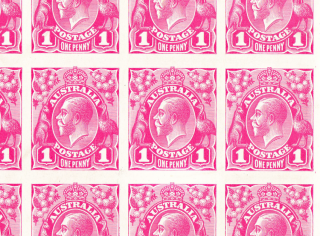The unique set of Perkins Bacon proof sheets of the 1914 1d George V stamp were exhibited in the Court-of-Honour at Australia 2013, in Melbourne during May, through the courtesy of Richard Juzwin Stamps.
The British stamp printer, Perkins Bacon & Co., was contracted by the Australian government to manufacture a 1d letterpress die, four 1d steel printed plates each 120-on and three undenominated stamp dies. This work was carried out in London in 1914 under the supervision of Seymour Bennett, Inspector of Stamping at Somerset House, in which role he supervised the production of all British stamp dies and plates.
The George V dies and plates were shipped to the Stamp Printing Office, Melbourne, and the first issue of 1d George V stamps occurred in mid-July 1914. The new stamp had been introduced to replace the 1d Kangaroo stamp for basic letter postage and much reviled by those who thought the stamp was too plain and ought to feature the kings portrait. The 1d George V printing plates were in use for 23 years, during which time wear on the solid, steel plates was minimal. At the outset of their use in 1914, the requirement of 1d stamps amounted to more than 10,000 sheets a day.
Each of the four 1d printing plates consists of 120 stamp impressions arranged in two panes of 60 (ten horizontal rows of six stamps). Usually, all four 1d plates were clamped together to produce 480-on sheets that were subsequently trimmed into 120-on sheets for distribution to post offices.
After the plates had been manufactured, Perkins Bacon took pulls from each plate in various colours. These sheets came into the market in 1935 following the closure of the printing business. Several sheets were broken up, but this set comprises all but one of the only remaining intact sheets (the other sheet was acquired by King George V himself and is in the Royal Philatelic Collection). This set of six proof sheets was originally acquired by a British Philatelist, T.E. Field, and later purchased by an Australian Philatelist, A.J. Kilfoyle. The next owner was a British Philatelist A.S. Davidson, who exhibited the sheets in the Court-of-Honour as Ausipex 84′ in Melbourne. After Davidson’s death, the sheets were acquired by Melbourne Stamp Dealer Richard Juzwin.
Two make-ready proof sheets of plate one in black and plate three in blue are roughly printed. On the reverse side of the plate one sheet is a pull in violet of plate four. Three sheets, two in black and the third in carmine rose, are from plate two. Finally, one sheet in dull mauve is from plate four. Thus all four printing plates are represented. The plate one sheet is of particular significance as it contains unique examples in proof formate of the 20 Die 2 stamps in the second and third columns of the right pane. Also stamp no.40 of plate four is the pre-retouch state, which exhibits a white blemish that was retouched to create the thin ‘G’ variety (in POSTAGE), prior to the despatch of the plates to Australia.
